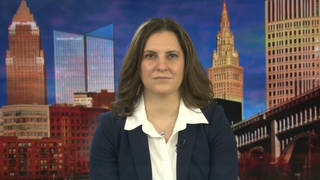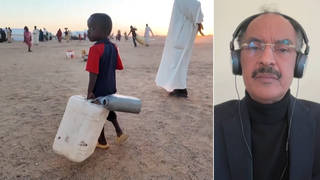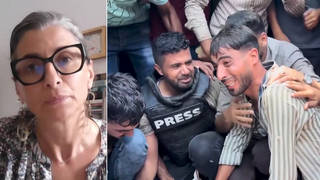
Guests
- James Smithemergency medical doctor who recently treated patients at Al-Aqsa Hospital in Gaza.
Before Israel’s unprecedented assault on Gaza, the territory had 36 functioning hospitals. Now only 16 partially functioning health facilities remain. As Israeli bombs and ground troops approach Nasser Hospital, the largest remaining partially functioning health facility in Gaza, we speak with Dr. James Smith, an emergency medical doctor recently returned from Gaza, where he worked alongside Palestinian healthcare workers to treat patients at Al-Aqsa Hospital. “Every single day, without exception, there were multiple mass casualty incidents at the hospital,” says Smith. “They would include open chest wounds, open abdominal wounds, traumatic amputations, severe full-thickness burns … really some of the most horrific traumatic injuries that I have ever seen.”
Transcript
AMY GOODMAN: This is Democracy Now!, democracynow.org, The War and Peace Report. I’m Amy Goodman.
Israeli forces are pushing further into southern Gaza, with airstrikes and ground troops attacking areas that Israel had previously told Palestinians to flee to as safe zones. Over the past few days, Israel has bombed areas close to Nasser Hospital, the largest remaining semi-functioning health facility in Gaza, located in the southern city of Khan Younis. Gaza only has 16 partially functioning health facilities remaining. Before Israel’s assault, Gaza had 36 hospitals. The hospitals that are still working are operating far beyond their capacity, have been turned into makeshift refugee camps to house the displaced — and makeshift morgues — with health officials describing the situation as catastrophic. The Health Ministry estimates that over 60,000 people have been wounded in Gaza, with hundreds more casualties every day. The casualty count at this point is nearing 25,000, more than 10,000 of them children.
For more, we’re joined by Dr. James Smith, an emergency medical doctor who just returned from Gaza earlier this month, where he worked alongside Palestinian healthcare workers to treat patients at Al-Aqsa Hospital located in Deir al-Balah in the middle of the Gaza Strip. Dr. James was in Gaza with the organization Medical Aid for Palestinians. He’s joining us now from London.
Dr. James, welcome to Democracy Now! Describe what you saw, what you confronted, the work you were doing, what’s happening at Al-Aqsa Hospital.
DR. JAMES SMITH: Hi, Amy.
So, yes, as you say, I was working with a team. There were 10 of us. Myself, I was with the organization Medical Aid for Palestinians. We were accompanied by colleagues from the International Rescue Committee. And very importantly, we were — it’s important to really reiterate that we were working with our Palestinian colleagues, so doctors, nurses, other healthcare professionals, at Al — sorry, at Al-Aqsa Hospital. Al-Aqsa is a hospital based in the middle area of Gaza, so south of Gaza City and north of Khan Younis.
Myself, I was working in the emergency room. So, we would position ourselves in the ER every morning and, really, at that point, wait to see what the day would bring. Every single day, without exception, there were multiple mass casualty incidents at the hospital. So that’s several patients presenting at a time with traumatic injuries of varying severity. Those patients would require stabilization and then often transfer through to the operating room for surgical intervention. Some patients would require palliative care, if we were able to provide some form of palliative care, and in addition to many, many trauma patients. And by “many,” I mean several hundred over the time that we were working at Al-Aqsa. We were also treating patients presenting with complex medical problems, so people that had suffered heart attacks, for example, had suffered from strokes, and people whose hypertension or diabetes management had been negatively impacted, usually through a lack of access to their usual medication or because they hadn’t been able to see their usual doctor for several months. And then, furthermore, we were also seeing an even greater number of people with, effectively, primary healthcare-level problems.
So, the entirety of the primary healthcare or community care system in Gaza has completely collapsed. In fact, the entire healthcare system, the Ministry of Health has already announced several months ago, has completely collapsed. But that meant that anyone presenting with so-called, well, more minor complaints — coughs, colds, diarrheal illnesses — they were all also presenting to the emergency room to be seen by the doctors and nurses there.
AMY GOODMAN: Can you talk about treating children, Dr. James?
DR. JAMES SMITH: Sure. So, as you’ve mentioned, a significant proportion of the people that have been killed since the start of this escalation are children. We certainly saw every mass casualty incident in the emergency room. There were several children also present. I remember very vividly some of the most traumatic injuries inflicted upon people were inflicted upon children. And they would include open chest wounds, open abdominal wounds, traumatic amputations, severe full-thickness burns to a substantial proportion of the body area — really some of the most horrific traumatic injuries that I have ever seen.
AMY GOODMAN: We’re actually showing images for our TV audience of Al-Aqsa Hospital and of the children and the adults who have been wounded there. You know, it’s really important to point out, if you’re talking about a hospital in normal times that has repeatedly been attacked, it would — and that’s severely compromised in its functioning, but we’re talking about this constant bombardment, where you have people coming in who have been severely wounded. You have people taking refuge there. And is it both like a refugee camp and a morgue?
DR. JAMES SMITH: So, there were several thousand people that had sought supposed sanctuary within the hospital compound itself. And we’ve seen this in several other hospitals across the Gaza Strip. There were reports, for example, of thousands of people sheltering in the Al-Shifa compound before that was surrounded and raided by the Israeli occupation forces. The same was the case at Al-Aqsa. So there were people staying in makeshift tents in and around the hospital buildings. Just up the main street adjacent to the hospital, sort of another IDP camp, internally displaced persons camp, had sort of formed very organically on open land. As the Israeli ground forces moved closer to the hospital and as the bombardment, the artillery and air bombardment, intensified, many of those — many thousands of those displaced people have displaced further south towards Rafah. And that also includes patients who were in the hospital at the time that we were working there. Many of them have also fled, along with many of the staff, as well.
AMY GOODMAN: I wanted to go to a clip, and it’s really important to play these clips. Right now Gaza has experienced the longest communications blackout of this Israeli attack for the last three months. I think it’s something like seven days. So it’s really hard to get information inside this intense Israeli bombardment in the vicinity of Nasser Hospital, the main hospital in Khan Younis, the largest remaining semi-functioning health facility in Gaza, and tanks and armored vehicles are on the main road leading to the area. On Wednesday, Democracy Now! reached Dr. Ahmed Moghrabi, who works in Nasser Hospital. He described the situation on the ground and the difficulty in getting out any messages. This is what he had to say.
DR. AHMED MOGHRABI: Thank you, sister, for asking about us. Thank you for letting me speak out here. We don’t have internet at all. I managed to get a very weak signal. I can’t upload any of these videos. Here, 90% of people who are already evacuated at the hospital, they evacuated from the hospital. Ninety percent of medical personnel evacuated from the hospital.
And this is my little daughter, actually. She got head trauma Saturday. You know, hundreds of these evacuating people at the corridor, somebody pushed her, and she fell on her head. Now I’m taking care about my — this little girl. She needs medicine. She’s not well. So I stay at the hospital now, but I want to evacuate. The situation is catastrophic, sister. Really, I’m very tired. I’m very tired.
AMY GOODMAN: That’s Dr. Ahmed Moghrabi, and the image we’ve been showing as he spoke was Dr. Moghrabi holding his own wounded daughter. I’m wondering, Dr. James, if you can talk about the significance, the medical significance, of a complete — almost complete telecommunications blackout, in terms of ambulances being reached, people being able to communicate to get help.
DR. JAMES SMITH: Absolutely. I mean, this is a catastrophic development. As you’ve mentioned, Amy, this, I think, is the seventh time that the Israelis have suspended access to telecommunications across almost the entirety of the Gaza Strip. This is now day six or seven of a complete sort of telecommunications blackout. It makes it almost impossible to do anything.
So, in the first instance, people can’t reach their families, their loved ones. They can’t communicate with colleagues. They can’t reassure family that they’re OK, or indeed relatives and friends can’t inform family members and so on when somebody has been killed or injured. There have been occasions where the emergency number has not been in use. So, as you say, it’s been difficult to call ambulances or mobilize ambulances to places where there has been an air or artillery strike. It makes it very difficult for health and humanitarian workers to do their essential work —
AMY GOODMAN: Dr. Smith, we —
DR. JAMES SMITH: — so they can’t coordinate with each other.
AMY GOODMAN: We only have 10 seconds. What message do you have for the world, just having come out of Gaza? Ten seconds.
DR. JAMES SMITH: The violence needs to end immediately.
AMY GOODMAN: Dr. James Smith, emergency medical doctor, just back from Gaza, where he worked to treat patients at Al-Aqsa Hospital.
That does it for our show. Democracy Now! has job openings. Check democracynow.org.













Media Options